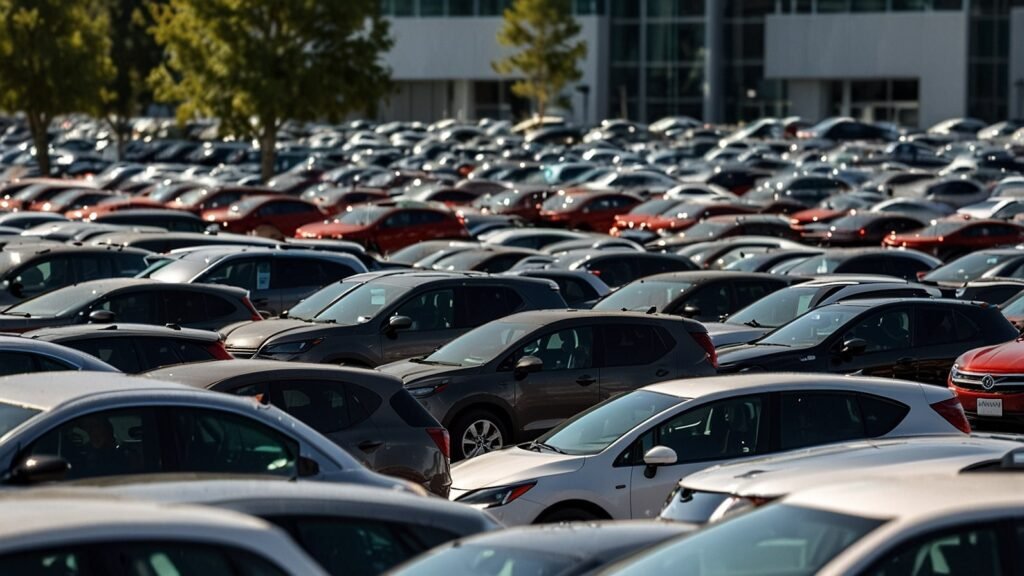
New vehicle inventory has soared to its highest levels in years, and this is an important turn that the dealerships are preparing to receive the new 2026 model-year vehicles. Stocks have risen by approximately 15 per cent in the middle of September 2025, as compared to the same month last year, as tracked by industry watchers.
This accumulation, enabled by stabilised chains of supply and brash production slurry of the giant producers, is redefining consumer anticipation and dealer policy countrywide. To those consumers who are looking at their next ride, the time could not be any better, or more opportunistic.
The inventory increase is not a fleeting flash on the radar; it is an indicator of the industry’s strength, as the pandemic-related shortages have left many empty shelves with prices soaring. As the market is saturated by the rise of electric vehicles (EVs) and hybrids, car manufacturers are struggling to outwit each other by launching new models to the market before the next wave of innovations reaches the showroom floor. But what is it to the typical car shopper? Reduced prices on the stickers, increased bargaining ability and an expanded range of options as 2025 vehicles are cleared to allow the coming models of today with their technology to arrive.

The Surge: What Is Behind the Inventory Boom?
It is in a convergence of world and domestic aspects that this inventory amplification is rooted and has culminated in a favourable condition of abundance. U.S. car manufacturers such as Ford and General Motors recalibrated production lines after the shortage of semiconductors and factory closures brought manufacturing to a halt in 2022. By early 2025, domestic chip manufacturing investments, with the boost of the CHIPS Act, started to give dividends, and assembly facilities in Michigan, Ohio, and Tennessee were humming along at close to full capacity.
- Ford: 20% more F-Series trucks produced this quarter alone
- Stellantis: Increased Jeep and Ram production to satisfy waiting lists
- Foreign suppliers (Mexico & South Korea): Deliver parts without delays
The result? Where empty lots used to be ringing with silence, dealerships are now booming markets, and the supply of any individual model is averaged out at 55 days–an increase to 38 days in 2024.
It is particularly acute in the EV segment:
- Tesla: Gigafactory expansions flooding the pipeline
- Rivian: Scaling production
- Chevrolet Silverado EV & Toyota bZ4X: Piling up in stock
According to analysts, the softening in raw materials (lithium prices fell 30% annually) is enabling manufacturers to produce without the fear of overstocking write-downs.
However, not all is smooth sailing. Strikes at certain plants in the first half of the year had stopped production, but union agreements have since restored the labour force. The net consequence: a flooded market with choices ranging from affordable sedans to luxury SUVs.
Consumer Effect: Bargains and Deals Galore
To the average consumer, this stocking up spurt is a buyer’s market not observed since pre-pandemic times. Average new car prices have dropped:
- 2023: $48,000
- 2025: ~$45,500 (with incentives driving effective prices lower)
Dealerships are offering rebates of up to $2,500 on average per unit—more than last year.
Example: Sarah Jenkins, a 34-year-old from Denver, purchased a 2025 Honda CR-V hybrid at a price under $4,000 below MSRP. She said, “I went in with the idea of spending an hour haggling, and they literally threw the keys at me.”
The EV boom further boosts these savings:
- Hyundai & Kia: Free at-home chargers & longer warranties
- Secondary markets: Demo EV models with low mileage flooding in
Segment differences:
- Luxury brands (BMW & Mercedes-Benz): Slower growth (~10%)
- Entry-level compacts: Booming with young professionals and families
- Financing rates: 6.5% for prime borrowers; subprime lenders urge caution
Strategies of the Manufacturers: Bets on 2026
Automakers are focused on 2026 models, treating current excess as a buffer. Key moves include:
- Ford: Refresh of Maverick hybrid (50 mpg target)
- GM: Bolt EUV follow-up with solid-state batteries (400-mile range)
- Toyota: Hoarding Prius and RAV4 hybrids, investing in hydrogen fuel cells
- Volkswagen: Importing ID.Buzz van with U.S. modifications
- BYD (China): Atto 3 crossover priced below $30,000
Sustainability also takes centre stage: Example—2026 Ford Mustang Mach-E using recycled ocean plastics.
Outlook: Stable, but a Volatile Market
Analysts predict stable inventories until 2026, barring disruptions (e.g., South China Sea unrest). Cox Automotive forecasts:
- 2.5 million unit sales in Q4 2025 (+8% over 2024)
Risks:
- Inflation (2.8%) may push interest rates up
- Self-driving tech faces regulatory hurdles
- Trade policy shifts could affect luxury imports
On the positive side, used car values are levelling off as supply improves, narrowing the price gap with certified pre-owned vehicles.
Shopping: How to Meet the New Shift
Tips for buyers:
- Best deals occur mid-month when sales goals loom
- Use tools like Edmunds & Kelley Blue Book to find understocked areas
- Consider leasing (3-year contracts = flexibility for fast-evolving tech)
- Take advantage of EV incentives ($7,500 credit underthe Inflation Reduction Act)
Final Outlook
Simply, the U.S. new vehicle inventory increase before 2026 models is not only a numbers game, but a revival of accessibility in mobility. From busy lots in Texas to Florida showrooms, the atmosphere is electric. With engines running at full steam toward tomorrow, the present-day abundance ensures no one is left behind.
This rush highlights resilience: to consumers, it means empowerment; to manufacturers, it is a canvas for reinvention. By 2026, fleets will be faster, greener, and more sensitive to the needs of American drivers.

